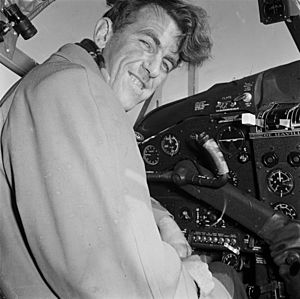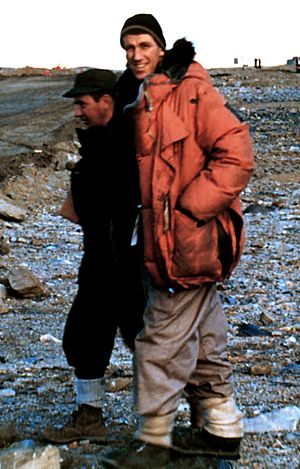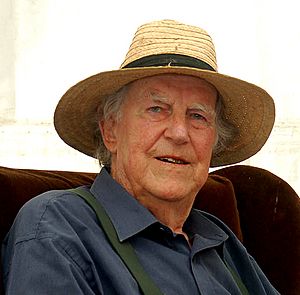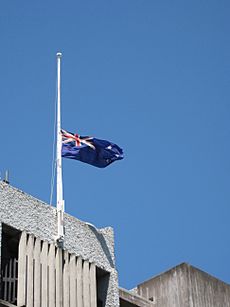Edmund Hillary facts for kids
Quick facts for kids
Sir Edmund Hillary
KG ONZ KBE
|
|
|---|---|
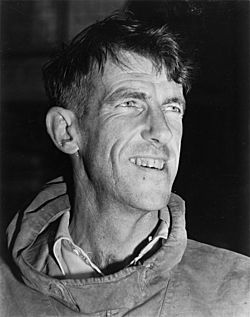
Edmund Hillary in the early 1950's
|
|
| Born |
Edmund Percival Hillary
20 July 1919 Auckland, New Zealand
|
| Died | 11 January 2008 (aged 88) Auckland, New Zealand
|
| Cause of death | Myocardial infarction |
| Spouse(s) | Louise Mary Rose (1953-1975) June Mulgrew, QSM (1989-2008) |
| Children | Peter (1954) Sarah (1955) Belinda (1959-1975) |
| Parent(s) | Percival Augustus Hillary Gertrude Hillary, née Clark |
Sir Edmund Hillary (born 20 July 1919, died 11 January 2008) was a famous New Zealand mountain climber and explorer. He and his Sherpa guide, Tenzing Norgay, were the first people to successfully climb Mount Everest. They reached the very top of the world's tallest mountain on 29 May 1953.
Sir Edmund Hillary became famous for this amazing achievement. He is even featured on New Zealand's five-dollar banknote! After climbing Mount Everest, he went on to conquer ten more mountains in the Himalayas.
Contents
Sir Edmund Hillary: The Everest Conqueror
Early Life and Dreams
Edmund Hillary was born in Auckland, New Zealand, on 20 July 1919. When he was one year old, his family moved to Tuakau, a town south of Auckland. His father had received land there after serving in a war. Hillary's grandparents had moved to New Zealand from Yorkshire, England, in the mid-1800s.
Hillary went to Tuakau Primary School and then Auckland Grammar School. He finished primary school early but found high school difficult. He was smaller and shyer than other students. He often found comfort in books and dreamed of an adventure-filled life. He rode a train to school every day and used that time to read. Learning how to box helped him feel more confident.
When he was 16, Hillary became interested in climbing. This happened during a school trip to Mount Ruapehu. Even though he was very tall at 6 feet 5 inches (195 cm), he was also very strong. He was stronger than many of his friends who went hiking with him.
He studied mathematics and science at The University of Auckland. In 1939, he completed his first important climb. He reached the top of a mountain called Mount Ollivier. With his brother Rex, Hillary worked as a beekeeper in the summer. This allowed him to go climbing in the winter months.
Family Life and Tragedies

Edmund Hillary married Louise Mary Rose on 3 September 1953. This was soon after his famous climb of Everest. He was a shy person. He even asked his future mother-in-law to propose to Louise for him! They had three children: Peter (born 1954), Sarah (born 1955), and Belinda (1959–1975).
In 1975, a terrible accident happened. Louise and Belinda were on their way to meet Hillary in Nepal. He was helping to build a hospital there. Sadly, their plane crashed near Kathmandu airport. Both Louise and Belinda died.
In 1989, Hillary married June Mulgrew. She was the widow of his close friend, Peter Mulgrew. Peter had died in a plane crash in 1979. He had taken Hillary's place as a speaker on an Air New Zealand Flight 901 sightseeing trip to the Antarctic.
Hillary's son, Peter Hillary, also became a climber. He reached the summit of Everest in 1990. In 2002, Peter climbed Everest again. This was part of a 50th-anniversary celebration. Jamling Tenzing Norgay, Tenzing's son, was also on that trip. Sir Edmund Hillary also had six grandchildren.
When he was not on expeditions, Hillary lived in Auckland City. In his retirement, he enjoyed reading adventure and science fiction books. He also built a small holiday home, called a bach, at Whites Beach. This is one of Auckland's west coast beaches. His friend, Bob Harvey, said that this beach was Hillary's "second home." It was a place where he could find peace away from the media.
World War II Service

When World War II began, Hillary wanted to join the Royal New Zealand Air Force (RNZAF). But he changed his mind because of his beliefs. In 1943, the threat from Japan in the Pacific grew. Also, conscription (being forced to join the army) started. This made him change his mind again.
Hillary joined the RNZAF as a navigator. He served on Catalina flying boats. In 1945, he was sent to Fiji and the Solomon Islands. There, he was badly burned in a boat accident. He was then sent back to New Zealand to recover.
Preparing for Everest
On 30 January 1948, Hillary climbed Aoraki / Mount Cook. This is New Zealand's highest peak. He climbed it with Harry Ayres, Mick Sullivan, and Ruth Adams.
In 1951, Hillary joined a British team exploring Everest. This was before the successful climb in 1953. In 1952, Hillary and George Lowe were part of another British team. They tried to climb Cho Oyu. This attempt failed. After that, Hillary and Lowe crossed into Tibet. They reached an old camp on the northern side of Everest.
The Historic Everest Climb
The way to Everest through Chinese-controlled Tibet was closed. Nepal only allowed one expedition each year. A Swiss team, which included Tenzing, had tried to reach the top in 1952. But bad weather and tiredness forced them to turn back. They were only about 800 feet (240 meters) from the summit.
In 1952, Hillary learned that he and George Lowe were invited to join the British Everest attempt in 1953. He quickly said yes. Eric Shipton was chosen to lead the expedition. But he was later replaced by John Hunt. Hillary thought about leaving the team. However, both Hunt and Shipton convinced him to stay. Hillary had planned to climb with Lowe. But Hunt decided on two teams for the final push. These were Tom Bourdillon and Charles Evans, and Hillary and Tenzing. So, Hillary worked hard to build a strong friendship with Tenzing.
The Hunt expedition was huge. It had over 400 people, including 362 porters and 20 Sherpa guides. They carried 10,000 pounds (4,500 kg) of gear. It was a true team effort. Lowe helped prepare the Lhotse Face, a very steep ice wall. Hillary found a safe path through the dangerous Khumbu Icefall.
The team set up their base camp in March 1953. They worked slowly, setting up camps higher and higher. Their final camp was at the South Col, at 25,900 feet (7,900 meters). On 26 May, Bourdillon and Evans tried to reach the summit. But they had to turn back when Evans' oxygen system failed. They had reached the South Summit, very close to the top. Hunt then told Hillary and Tenzing to try for the summit.
Snow and wind kept Hillary and Tenzing at the South Col for two days. They set out on 28 May with three support climbers: Lowe, Alfred Gregory, and Ang Nyima. Hillary and Tenzing set up a tent at 27,900 feet (8,500 meters) on 28 May. Their support team then went back down the mountain. The next morning, Hillary found his boots frozen solid outside the tent. He spent two hours warming them. Then, he and Tenzing, carrying 30-pound (14 kg) packs, began the final climb.
The most important part of the last climb was a 40-foot (12-meter) rock face. It was later named the "Hillary Step". Hillary found a way to climb up a crack between the rock wall and the ice. Tenzing followed him. From there, the rest of the climb was easier. Hillary said that both men reached the summit at the same time. But in his book, Tenzing said Hillary took the first step onto the top of Mount Everest.
They reached Everest's summit, 29,028 feet (8,848 meters) high, at 11:30 am. Hillary described it: "A few more whacks of the ice axe in the firm snow, and we stood on top."
They stayed at the summit for only about 15 minutes. Hillary took the famous photo of Tenzing posing with his ice-axe. But there is no photo of Hillary at the summit. BBC News said this was because Tenzing had never used a camera. However, Tenzing wrote in his book that Hillary did not want his picture taken. Tenzing left chocolates in the snow as an offering. Hillary left a cross that John Hunt had given him. They also took more photos looking down the mountain. This was to prove they had reached the top.
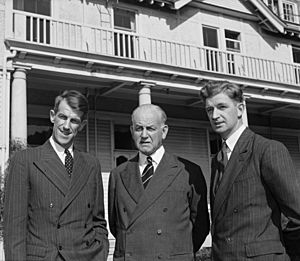
The two climbers had to be careful on the way down. Drifting snow had covered their tracks, making it hard to follow their steps. The first person they met was Lowe. He had climbed up to bring them hot soup.
News of their success reached Britain on the day of Queen Elizabeth II's coronation. The newspapers called it a "coronation gift." All 37 members of the team received the Queen Elizabeth II Coronation Medal. Hillary and Hunt were made knights by the Queen. Tenzing, who was a Nepalese citizen, could not be knighted. But he received the George Medal from the British Government for his efforts.
Adventures After Everest
Hillary climbed ten more peaks in the Himalayas during later trips. These were in 1956, 1960–1961, and 1963–1965. He also reached the South Pole on 4 January 1958. This was part of the Commonwealth Trans-Antarctic Expedition. He led the New Zealand part of this journey. His team was the first to reach the Pole by land since 1912. They were also the first to do it using motor vehicles.
In 1962, he was a guest on a TV show called What's My Line?. The show's panel had to guess who he was while blindfolded. He managed to stump them, meaning they could not guess his identity.
In 1977, he led a jetboat trip called "Ocean to Sky." They traveled from the mouth of the Ganges River to its source. Between 1977 and 1979, Hillary also gave talks on Antarctic sightseeing flights for Air New Zealand. He was supposed to be on Air New Zealand Flight 901 on 28 November 1979. But he had to cancel due to work. His friend, Peter Mulgrew, took his place. Sadly, the plane crashed into Mount Erebus in Antarctica. All 257 people on board died. Hillary later married Mulgrew's widow, June.
In 1985, he went with Neil Armstrong (the first man on the Moon) to the North Pole. They flew in a small plane over the Arctic Ocean and landed there. This made Hillary the first person to stand at both the North and South Poles, and on the summit of Everest.
Hillary was very upset about a decision not to rescue David Sharp. Sharp was an Everest climber who died on the mountain in 2006. Hillary said it was wrong to leave other climbers to die. He felt that getting to the summit had become too important. He said, "I think the whole attitude towards climbing Mount Everest has become rather horrifying. The people just want to get to the top. It was wrong if there was a man suffering altitude problems and was huddled under a rock, just to lift your hat, say good morning and pass on by."
In January 2007, Hillary visited Antarctica again. This was to celebrate 50 years since Scott Base was founded. He asked the British government to help pay for the upkeep of Robert Falcon Scott's and Ernest Shackleton's old huts.
In April 2007, Hillary fell during a trip to Kathmandu. He was later taken to a hospital in New Zealand.
How He Was Honored
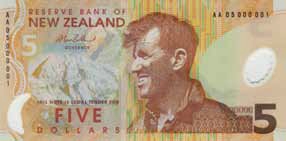
On 6 June 1953, Hillary was made a Knight Commander of the Order of the British Empire. He also received the Queen Elizabeth II Coronation Medal that year. On 6 February 1987, he became the fourth person to join the Order of New Zealand. On 22 April 1995, Hillary was made a Knight Companion of The Most Noble Order of the Garter.
The government of India gave him its second-highest civilian award, the Padma Vibhushan, after he died in 2008. He also received the Polar Medal in 1958 for his work in Antarctica. The Kingdom of Nepal gave him the Order of Gorkha Dakshina Bahu, 1st Class in 1953. In 2004, he received the Commander's Cross of the Order of Merit of the Republic of Poland.
To celebrate 50 years since the first Everest climb, the Nepalese government made Hillary an honorary citizen. He was the first foreign person to receive this honor.
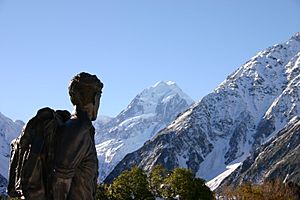
In 1992, Hillary appeared on the New Zealand $5 note. This made him the only New Zealander to be on a banknote while still alive. Usually, only people who have passed away are shown. The head of the Reserve Bank at the time, Don Brash, wanted to use a deceased sportsperson. But he couldn't find a good one. So, he asked Hillary for permission. Hillary agreed, but he insisted that Aoraki/Mount Cook be shown in the background instead of Mount Everest. The banknote also shows a Ferguson TE20 tractor. Hillary used a similar tractor to reach the South Pole.
In 2005, a poll by Reader's Digest named Hillary "New Zealand's most trusted individual." He kept this title in 2006 and 2007.
Hillary's favorite charity in New Zealand was the Sir Edmund Hillary Outdoor Pursuits Centre. He was its patron for 35 years. He loved how this group helped young New Zealanders experience the outdoors. This was similar to his own first school trip to Mt Ruapehu at age 16.
A 2.3-meter (7.5-foot) bronze statue of "Sir Ed" stands outside The Hermitage Hotel at Mount Cook Village. Hillary himself unveiled it in 2003. Many streets, schools, and organizations are named after him. For example, Sir Edmund Hillary Collegiate in Ōtara and Edmund Hillary Primary School in Papakura.
Two places in Antarctica are named after Hillary. The Hillary Coast is a part of the coastline south of Ross Island. The Hillary Canyon is an undersea feature in the Ross Sea.
Helping Others: His Legacy
After climbing Everest, Hillary spent much of his life helping the Sherpa people of Nepal. He founded the Himalayan Trust in 1960 and led it until he died in 2008. Through his efforts, many schools and hospitals were built in the remote Himalayas. He was also the Honorary President of the American Himalayan Foundation. This group helps improve the environment and living conditions in the Himalayas.
His Final Years
On 11 January 2008, Sir Edmund Hillary died in Auckland City Hospital. He was 88 years old. New Zealand Prime Minister Helen Clark announced his death. She said it was a "profound loss to New Zealand." Flags were lowered to half-mast on all government buildings and at Scott Base in Antarctica.

A state funeral was held for Hillary on 22 January 2008. His body was then cremated. On 29 February 2008, most of his ashes were scattered in Auckland's Hauraki Gulf. This was what he had wanted. The rest of his ashes went to a Nepalese monastery near Everest.
On 2 April 2008, a special service was held for him at St George's Chapel in Windsor Castle. The Queen and New Zealand leaders attended. Sir Edmund's family and Tenzing Norgay's family were also there.
Fun Facts About Edmund Hillary
- Edmund Hillary was also a beekeeper.
- In 1960, he joined an expedition to look for the Yeti. This is a creature thought to live in the Himalayas.
- He said about the Yeti: "The yeti is not a strange, superhuman creature as has been imagined. We have found rational explanations for most yeti phenomena."
- Edmund Hillary was 6 feet, 5 inches tall.
- His middle name was Percival.
- His first wife and daughter Belinda died in a plane crash in 1975.
Famous Words from Edmund Hillary
- "It is not the mountain we conquer but ourselves."
- "Life's a bit like mountaineering - never look down."
- "With practice and focus, you can extend yourself far more than you ever believed possible."
- "You don't have to be a hero to accomplish great things...to compete. You can just be an ordinary chap, sufficiently motivated to reach challenging goals."
Images for kids
See also
 In Spanish: Edmund Hillary para niños
In Spanish: Edmund Hillary para niños



